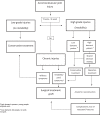Management of Acromioclavicular Injuries - Current Concepts
- PMID: 36814992
- PMCID: PMC9940602
- DOI: 10.2147/ORR.S340531
Management of Acromioclavicular Injuries - Current Concepts
Abstract
Introduction: Treatment of a patient with acromioclavicular joint (ACJ) injury remains challenging for orthopedic surgeons. To date, there is debate over the optimal management of ACJ injuries. This review provides an overview of assessment, treatment, and future perspectives for the treatment of and research into ACJ.
Material and methods: A scoping literature review was performed. The search was built including the following terms: acromioclavicular joint injuries or dislocation, and pathophysiology, etiology, anatomy, treatment, and trauma mechanism. The papers with evidence levels 1-3 were included in the current narrative review.
Results: A total of 2242 potential relevant studies were identified in the searches. After removal of duplicates, 432 studies were screened on their titles and abstracts, resulting in 35 studies being included in the review, based on the eligibility criteria.
Conclusion: The management of acute and chronic ACJ injuries is not clarified in the current literature. However, there is currently insufficient high-level evidence for the overall treatment options for ACJ injuries. If surgical intervention is decided upon in consultation with the patient, the complications may not outweigh the benefits. The multitude of existing techniques is indicative of the uncertainty surrounding this issue, and no gold standard has yet been established for treatment methods. An ideal classification would include not only vertical and horizontal instability, but also the severity of kinematic alterations of the shoulder complex. This indicates the need for a new and improved diagnostic tool for the classification of ACJ injuries.
Keywords: Rockwood classification; acromioclavicular joint injury; instability; operative treatment; rehabilitation; semitendinosus graft.
© 2023 de Groot et al.
Conflict of interest statement
Dr Derek FP van Deurzen reports personal fees and grants from Wright Medical and reports fellowship funding from Smith and Nephew. The authors report no other conflicts of interest in this work.
Figures





Similar articles
-
Injury patterns of the acromioclavicular ligament complex in acute acromioclavicular joint dislocations: a cross-sectional, fundamental study.BMC Musculoskelet Disord. 2016 Sep 6;17(1):385. doi: 10.1186/s12891-016-1240-3. BMC Musculoskelet Disord. 2016. PMID: 27600992 Free PMC article.
-
Arthroscopic Coracoclavicular Ligament Reconstruction for Acromioclavicular Joint Dislocation.J Nippon Med Sch. 2018;85(3):166-171. doi: 10.1272/jnms.JNMS.2018_85-24. J Nippon Med Sch. 2018. PMID: 30135343
-
Surgery improves the clinical and radiological outcome in Rockwood type IV dislocations, whereas Rockwood type III dislocations benefit from conservative treatment.Knee Surg Sports Traumatol Arthrosc. 2021 Jul;29(7):2143-2151. doi: 10.1007/s00167-020-06193-0. Epub 2020 Aug 3. Knee Surg Sports Traumatol Arthrosc. 2021. PMID: 32748232
-
Management of acute acromioclavicular joint dislocations: current concepts.Arch Orthop Trauma Surg. 2013 Jul;133(7):985-95. doi: 10.1007/s00402-013-1748-z. Epub 2013 Apr 30. Arch Orthop Trauma Surg. 2013. PMID: 23632779 Review.
-
Acromioclavicular joint separations grades I-III: a review of the literature and development of best practice guidelines.Sports Med. 2012 Aug 1;42(8):681-96. doi: 10.2165/11633460-000000000-00000. Sports Med. 2012. PMID: 22784232 Review.
Cited by
-
Acromioclavicular Joint Augmentation Poststabilization Using Knotless Anchors.Arthrosc Tech. 2024 Aug 9;14(1):103161. doi: 10.1016/j.eats.2024.103161. eCollection 2025 Jan. Arthrosc Tech. 2024. PMID: 39989705 Free PMC article.
-
Acromioclavicular Joint Injury: A Bibliometric Analysis of the 50 Most Cited Articles.Arch Bone Jt Surg. 2025;13(7):395-405. doi: 10.22038/ABJS.2024.81587.3759. Arch Bone Jt Surg. 2025. PMID: 40787290 Free PMC article. Review.
-
Current trends in surgical treatment of the acromioclavicular joint injuries in 2023: a review of the literature.JSES Int. 2023 Dec 18;8(3):389-393. doi: 10.1016/j.jseint.2023.11.018. eCollection 2024 May. JSES Int. 2023. PMID: 38707567 Free PMC article. Review.
-
Surgical Advances in the Treatment of Acromioclavicular Joint Injury: A Comprehensive Review.Med Sci Monit. 2024 Nov 16;30:e942969. doi: 10.12659/MSM.942969. Med Sci Monit. 2024. PMID: 39548667 Free PMC article. Review.
-
Surgical treatment for fracture of the medial end of the clavicle associated with ipsilateral acromioclavicular dislocation.Trauma Case Rep. 2023 Sep 24;48:100938. doi: 10.1016/j.tcr.2023.100938. eCollection 2023 Dec. Trauma Case Rep. 2023. PMID: 37915534 Free PMC article.
References
-
- Keener JD. Acromioclavicular joint anatomy and biomechanics. Oper Tech Sports Med. 2014;22(3):210–213. doi:10.1053/j.otsm.2014.02.018 - DOI
Publication types
LinkOut - more resources
Full Text Sources

